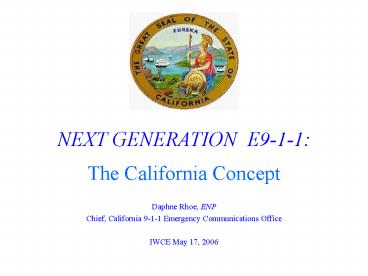NEXT GENERATION E911: - PowerPoint PPT Presentation
1 / 18
Title:
NEXT GENERATION E911:
Description:
IWCE - May 17, 2006. 1. NEXT GENERATION E9-1-1: The California Concept. Daphne Rhoe, ENP. Chief, California 9-1-1 Emergency Communications Office. IWCE May 17, 2006 ... – PowerPoint PPT presentation
Number of Views:86
Avg rating:3.0/5.0
Title: NEXT GENERATION E911:
1
- NEXT GENERATION E9-1-1
- The California Concept
- Daphne Rhoe, ENP
- Chief, California 9-1-1 Emergency Communications
Office - IWCE May 17, 2006
2
Existing California Infrastructure
- 500 PSAPs
- 390 Primary
- 100 Secondary
- 2 E9-1-1 Service Providers
- ATT
- Verizon
- 46 Selective Routers (7 in the LA region alone)
- Frame Relay Packet Data Network for intra-
inter-network data transfers - CAMA Trunks
3
(No Transcript)
4
NGEN - Benefits
- Why put E9-1-1 applications on standard
interfaces and protocols? - Vendor interoperability to drive competition
- Upgrade functionality with software, rather than
hardware - Why connect to NGEN Managed IP Network?
- Access to growing number of database needs
- Robust, diverse connectivity to minimize
isolation - Shared access for voice and data services to
drive down costs - More graceful transition to support emerging
technologies - Why VoIP?
- Improvements in functionality, flexibility,
performance, and control
5
NGEN Project Plan (4 Parts)
Part 1 NGEN Technical Specifications. Develop
SOW and select contractor to perform analysis to
develop technical (system functional)
specifications Part 2 NGEN Request for
Proposals. Modify specifications and develop
RFPs Part 3 Select NGEN Vendors. Coordinate
bid with the State Procurement Division and
select vendors Part 4 NGEN Implementation.
Strategically migrate to new NGEN system
according to rollout plan
6
NGEN - Project Objective
- Deploy a Next Generation E9-1-1 Network (NGEN)
for public safety in the State of California to
manage the increasing number of 9-1-1 wireless
and telematics calls to the PSAPs
7
California Pilot
- Stages, Objectives and Deliverables
8
Pilot Participants
- 14 city and county agencies in the Greater San
Francisco Bay Area have agreed to take part in
the Pilot
9
Pilot Stages Planning
- Planning
- Identify Pilot Participants
- Identify Center Location
- Develop Pricing
- Grant Development
- Identify Grant Sources
- Independent Grant Writer
- Working with Mercuri3 and PSAPs
- PSAPs Submit Grant Applications
10
Pilot Stage 1
- Planning
- Identify Pilot Participants
- Identify Center Location
- Design Network
- High capacity, secure and survivable
- Initial Connections
- Initial MLDB Development and Testing
- Establish Connections for Wireless and VoIP
- Simulated 9-1-1 calls
- Route to appropriate PSAP systems located at
Center based on PSAP boundary information - Begin Network Deployment
11
Pilot Stage 2
- Complete Network Deployment
- Network Load Testing
- Security Testing
- Complete MLDB Development
- Begin MLDB Data Load
- PSAP Boundaries
- Full cell/sector and geo routing capability
- Move PSAP Test Systems to Actual PSAP Locations
- Test Call Delivery
- Develop and Define CAD Interfaces
12
Pilot Stage 3
- Complete Network
- Load and Security Testing
- Complete MLDB Loading and Testing
- Deploy Pilot Systems to Call Taker/ Dispatch
Stations at PSAPs - Integrated or Parallel Systems TBD
- Train Call Takers/Dispatchers on System
Operations - Deliver Wireless and VoIP 9-1-1 Calls
- Maintain Parallel Wireless Systems During Cutover
13
Objectives Deliverables
- Stage 1
- Project Plan and Timeline
- MLDB Definitions
- Network Design and Security Specifications
- Stage 2
- Network SLAs and Operating Procedures
- PSAP Equipment Interface Specifications
- Stage 3
- Repeatable System Specifications
- Final Project Analysis Report
14
EM/HS Deliverables
- Demonstration of Real Time SES Data Sharing
- AVL where available
- Real time calls in progress
- Server based CAD capabilities
- Enhanced SES data interlinks to CAD server
- Radio Interoperability Demonstration
- Packet radio interconnect
- Remote dispatch/call overflow demonstrations
- Disaster Recovery Demonstration
- Re-route calls in real time from smaller
communities to remote center - Remote dispatch in disaster recovery demonstration
15
PSAP Participation Impact
- Stage 1
- Participation
- Planning sessions
- Existing equipment and software identification
- Impact
- None Anticipated
- Stage 2
- Participation
- Continued Interface with Incumbent Vendors
- Network Connections to be Installed
- Make Space Available for Test Systems
- Impact
- Network Connections to be Installed
- Test Systems to be Installed
16
PSAP Participation Impact (Contd)
- Stage 3
- Participation
- Systems Moved to Call Taker/Dispatcher Positions
- May be integrated with existing systems or run
parallel (TBD) - Call Taker/Dispatcher Training
- Impact
- Interface to Existing Systems
- Training Time Required
- Live Call Switch Over and System Monitoring
- EM/HS Demonstrations
- Remote Dispatch/Disaster Recovery tests
17
The Future
- Our Goal is to
- provide more services and capabilities
- deploy new technologies more quickly and more
easily - provide a more cost effective solution for 9-1-1
and more
18
California 9-1-1 Web Page
- www.td.dgs.ca.gov/services/911































